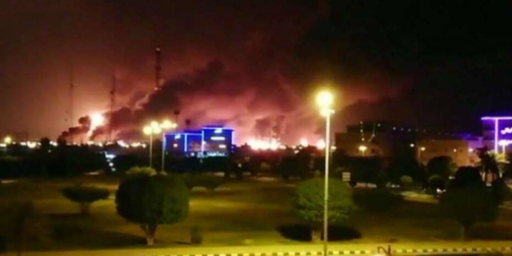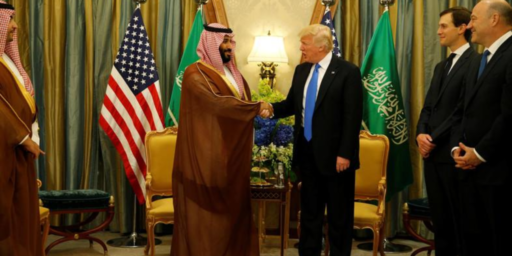Security Fences
Abigail Cutler has an interesting look at security fences as a tool of international relations in the current Atlantic Monthly.
This spring Israel is scheduled to withdraw from the Gaza Strip, but it plans to continue building a controversial 400-mile anti-terrorist barrier between itself and the West Bank. Though the International Court of Justice has ruled that the fence violates international law, it remains highly popular among Israelis—attacks have declined by as much as 90 percent in certain areas since construction began, two years ago. Similar security barriers have been constructed throughout history, from the Great Wall of China to the lesser-known wall between Israel and Gaza that was built in 1994. Today the West Bank barrier is just one of many partitions around the world aimed at repelling invaders—whether terrorists, guerrillas, or immigrants. Here are the sites of other notable security barriers, in chronological order of inception.
1. North Korea/South Korea: Called “the scariest place on earth” by President Bill Clinton, this 151-mile-long demilitarized zone has separated the two Koreas since 1953 and is the most heavily fortified border in the world.
2. Belfast, Northern Ireland: Nicknamed the “Peace Line,” this series of brick, iron, and steel barriers was first erected in the 1970s to curb escalating violence between Catholic and Protestant neighborhoods. The barriers have more than doubled in number over the past decade, and currently stretch over thirteen miles of Northern Ireland.
3. Cyprus: A 112-mile-long construction of concrete, barbed wire, watchtowers, minefields, and ditches has separated the island’s Turks from its Greeks since 1974. The Turkish Cypriot government reduced restrictions on cross-border travel in April of 2003.
4. Morocco/Western Sahara: Known as “The Wall of Shame,” these ten-foot-high sand and stone barriers, some mined, run for at least 1,500 miles through the Western Sahara. Built in the 1980s, they are intended to keep West Saharan guerrilla fighters out of Morocco.
5. India/Bangladesh: Aiming to curb infiltration from its neighbor, India in 1986 sanctioned what will ultimately be a 2,043-mile barbed-wire barrier. It’s expected to cost $1 billion by the time it is completed, next year.
6. India/Pakistan: In 1989 India began erecting a fence to stem the flow of arms from Pakistan. So far it has installed more than 700 miles of fencing, much of which is electrified and stands in the disputed Kashmir region. The anti-terrorist barriers will eventually run the entire 1,800-mile border with Pakistan.
7. Kuwait/Iraq: The 120-mile demilitarized zone along this border has been manned by UN soldiers and observers since the Gulf War ended, in 1991. Made of electric fencing and wire, and supplemented by fifteen-foot-wide trenches, the barrier extends from Saudi Arabia to the Persian Gulf. Last year Kuwait decided to install an additional 135-mile iron partition.
8. United States/Mexico: In the mid-1990s President Clinton initiated two programs, Operation Gatekeeper and Operation Hold the Line, to crack down on illegal immigration from Mexico. They produced a system of high-tech barriers, including a fourteen-mile fence separating San Diego from Tijuana. All told, security barriers stretch along at least seventy miles of the border.
9. Botswana/Zimbabwe: The government of Botswana claims to have started building a ten-foot-high electric fence along its border with Zimbabwe to control the spread of foot-and-mouth disease. However, most Zimbabweans believe that the fence—begun in 2003 and intended to stretch up to 300 miles—really aims to stanch the immigration flow from troubled Zimbabwe into calmer Botswana.
10. Saudi Arabia/Yemen: In 2003 Saudi Arabia began building a ten-foot-high barrier along its border with Yemen to prevent terrorist infiltration (you read that correctly). Heeding Yemeni protests that the fence violated a border treaty, the Saudi government vowed last year to complete the project in cooperation with Yemen.
An assessment of how well each has worked would seem in order. Off the top of my head, though, these barriers seem to have helped. Or, at least, their building has coincided with a reduction in previous tensions. The exception would appear to be the Tortilla Curtain between the U.S. and Mexico, where the flood of immigrants has continued unabated.






The UN HQ in Manhattan is also working on a security fence and perimeter.
Tortilla Curtain… I love it! That’s a great coinage.
” Tortilla Curtain… I love it! That’s a great coinage.”
You can thank TC Boyle for that.
This is exactly the type of succinct, clear writing needed to raise the level of public discourse on foreign policy issues in this country. Does anyone know where I can find more of Cutler’s writing?
Does the Atlantic Monthly realize what a gem they have in this woman? Just a fabulous piece of writing.